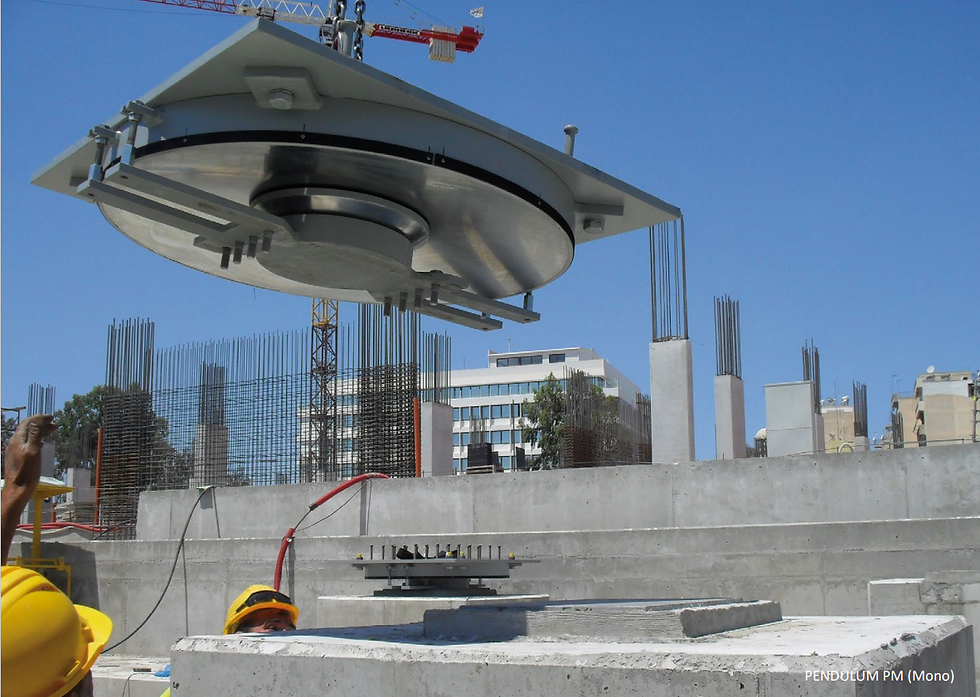Seismic Isolation in Bridge Design #7: Performance Overview and Foundation Design Considerations
- Varun Garg

- Apr 17, 2024
- 3 min read
Building on the detailed analysis of conventional versus Friction Pendulum Bearings (FPB) systems in bridge design, this post synthesizes the findings to offer an overview of how seismic isolation impacts the design of bridge foundations. We'll explore the overall comparison of base shear and bending moments, delve into the capacity design of foundations, and highlight the potential for cost and construction efficiencies through seismic isolation.
For a background on this study review Post #1 here.
Seismic Performance Overview
The seismic analysis conducted reveals a stark contrast in the seismic performance of bridges equipped with conventional bearings versus those utilizing FPB systems:
Base Shear Reduction: The application of FPB systems results in a substantial reduction in base shear forces. For instance, in the longitudinal direction, the design seismic coefficient with conventional bearings is significantly higher compared to the reduced coefficient achieved with FPB. This reduction directly impacts the design and sizing of foundation elements, potentially allowing for lighter and more cost-effective solutions.
Bending Moments: Similar to base shear, the bending moments experienced by the bridge foundation are markedly lower when FPB systems are employed. This reduction can lead to savings in reinforcement steel and concrete, reducing the overall environmental footprint and cost of the foundation.
Foundation Design Considerations
With the reduced seismic forces achieved through FPB, the foundation design can be optimized in several ways:
Size and Depth: The decrease in seismic forces allows for the design of smaller foundations, which are easier to construct and require less material. This is particularly beneficial in challenging site conditions or where material costs are high.
Pile Requirements: For bridges supported on piles, the reduced forces mean fewer piles may be required, or smaller pile sizes can be used. This can significantly impact the project's cost and timeline.
Construction Challenges: Reduced foundation sizes and complexities directly translate to fewer construction challenges, potentially leading to shorter construction timelines and reduced labor costs.
Capacity Design of Foundations
The capacity design approach ensures that in the event of seismic loading, the bridge superstructure remains protected by designing the substructure elements to yield first. This approach is critical in high seismic zones and is facilitated by the reduced seismic demands of FPB systems:
Overstrength Moment Capacity: With seismic isolation, the moments, and shears that the foundation must resist are lower, which can simplify the capacity design requirements and reduce the over-design often necessary for conventional systems.

Foundation Reinforcement: The reduced seismic demands allow for a more straightforward approach to reinforcing foundation elements, potentially using less reinforcement and simpler detailing.
Cost and Construction Efficiencies
The adoption of FPB systems in bridge design not only enhances seismic performance but also offers significant cost and construction efficiencies:
Material Savings: Reduced foundation sizes translate to material savings in concrete and steel, lowering the project's overall cost.
Labor and Time Savings: Simplified foundation designs can be constructed more quickly and with less labor, further reducing project costs and timelines.
Long-Term Maintenance: The self-restoring capability of FPB systems minimizes the potential for damage during seismic events, reducing the need for post-earthquake repairs and associated costs.
Conclusion
The overall comparison of seismic analysis results for conventional bearing systems versus FPB systems underscores the significant advantages of seismic isolation in bridge design, particularly for foundation design and construction. By effectively reducing seismic forces, FPB systems allow for more economical and environmentally friendly foundation solutions, simplify construction processes, and enhance the long-term resilience and sustainability of bridge structures. As we conclude this series, it's clear that the integration of seismic isolation technologies like FPB represents a forward-looking approach to designing bridges that are not only safer in the face of earthquakes but also more cost-effective and sustainable over their lifecycle.
This series is brought to you by Varun Garg, based on a paper he co-authored with Mr. Rajiv Ahuja for the Structural Engineering Digest, Quarterly Journal for the Indian Association of Structural Engineers in March 2021. The paper can be downloaded by clicking the link below.




Comments